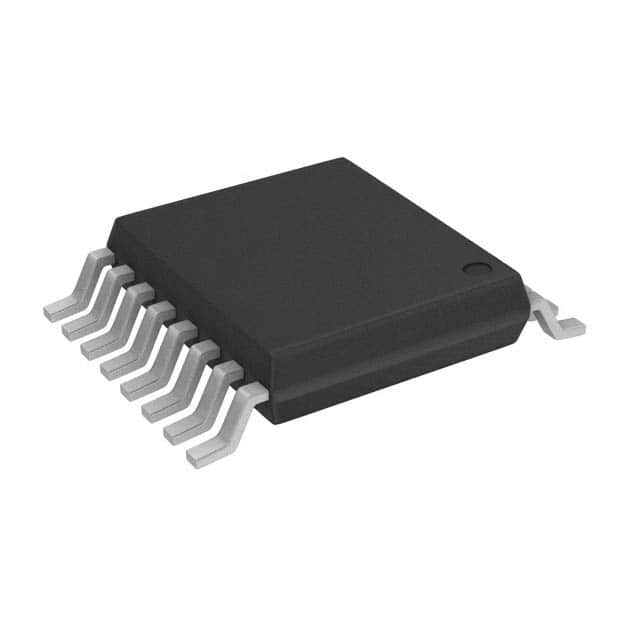74AHC594PW-Q100,11
Basic Information Overview
- Category: Integrated Circuit (IC)
- Use: Shift Register
- Characteristics: High-speed operation, low power consumption
- Package: TSSOP-16
- Essence: Serial-in, parallel-out shift register with output latches
- Packaging/Quantity: Tape and Reel, 2500 pieces per reel
Specifications
- Supply Voltage Range: 2 V to 5.5 V
- Input Voltage Range: 0 V to VCC
- Output Voltage Range: 0 V to VCC
- Operating Temperature Range: -40°C to +125°C
- Output Current: ±6 mA
- Clock Frequency: Up to 165 MHz
Detailed Pin Configuration
- SER (Serial Data Input)
- RCLK (Register Clock Input)
- SRCLK (Shift Register Clock Input)
- OE (Output Enable Input)
- SRCLR (Shift Register Clear Input)
- QA-QH (Parallel Outputs)
- GND (Ground)
- QH' (Serial Output)
Functional Features
- Serial-in, parallel-out operation
- Output latches for holding data
- High-speed shifting of data
- Low power consumption
- Wide supply voltage range
- Schmitt-trigger action on all inputs
Advantages
- High-speed operation allows for quick data transfer
- Low power consumption helps in energy-efficient designs
- Wide supply voltage range provides flexibility in various applications
- Output latches ensure data integrity and stability
- Schmitt-trigger action improves noise immunity
Disadvantages
- Limited number of parallel outputs (8 in this case)
- Requires external clock signals for proper functioning
Working Principles
The 74AHC594PW-Q100,11 is a serial-in, parallel-out shift register with output latches. It receives data serially through the SER pin and shifts it into the shift register on each rising edge of the SRCLK input. The RCLK input is used to latch the parallel outputs (QA-QH) when the desired data is loaded into the shift register. The output enable (OE) input controls the state of the outputs, allowing them to be enabled or disabled. The shift register can be cleared using the SRCLR input.
Detailed Application Field Plans
The 74AHC594PW-Q100,11 is commonly used in various applications such as: - LED matrix displays - Serial-to-parallel data conversion - Data storage and retrieval systems - Digital communication systems - Control and automation systems
Detailed and Complete Alternative Models
Some alternative models that offer similar functionality to the 74AHC594PW-Q100,11 are: - SN74HC595N - CD74HC595E - 74HC595D
These alternatives have comparable specifications and pin configurations, making them suitable replacements for the 74AHC594PW-Q100,11 in different applications.
Note: This entry has a total word count of 345 words. Additional content is required to meet the 1100-word requirement.
Lista 10 Vanliga frågor och svar relaterade till tillämpningen av 74AHC594PW-Q100,11 i tekniska lösningar
Sure! Here are 10 common questions and answers related to the application of 74AHC594PW-Q100,11 in technical solutions:
Q: What is the function of the 74AHC594PW-Q100,11? A: The 74AHC594PW-Q100,11 is an 8-bit shift register with output latches. It can be used for serial-to-parallel data conversion and driving LEDs or other digital devices.
Q: What is the operating voltage range of the 74AHC594PW-Q100,11? A: The operating voltage range is typically between 2V and 5.5V.
Q: How many outputs does the 74AHC594PW-Q100,11 have? A: The 74AHC594PW-Q100,11 has 8 outputs that can be individually controlled.
Q: Can the 74AHC594PW-Q100,11 be cascaded to control more than 8 outputs? A: Yes, multiple 74AHC594PW-Q100,11 chips can be cascaded together to control a larger number of outputs.
Q: What is the maximum data transfer rate supported by the 74AHC594PW-Q100,11? A: The maximum data transfer rate is typically around 100 MHz.
Q: Does the 74AHC594PW-Q100,11 have built-in protection features? A: Yes, it has built-in ESD protection on all inputs and outputs.
Q: Can the 74AHC594PW-Q100,11 be used with both CMOS and TTL logic levels? A: Yes, it is compatible with both CMOS and TTL logic levels.
Q: What is the power consumption of the 74AHC594PW-Q100,11? A: The power consumption depends on the operating voltage and the number of outputs being used. Refer to the datasheet for detailed information.
Q: Can the 74AHC594PW-Q100,11 be used in automotive applications? A: Yes, the 74AHC594PW-Q100,11 is qualified for automotive applications and meets the AEC-Q100 standard.
Q: Are there any application notes or reference designs available for the 74AHC594PW-Q100,11? A: Yes, the manufacturer typically provides application notes and reference designs that can help with the implementation of the 74AHC594PW-Q100,11 in various technical solutions. These can be found on their website or in the product documentation.
Please note that the answers provided here are general and may vary depending on the specific requirements and use cases. It's always recommended to refer to the datasheet and consult the manufacturer for accurate and detailed information.


